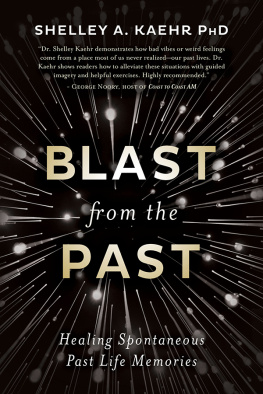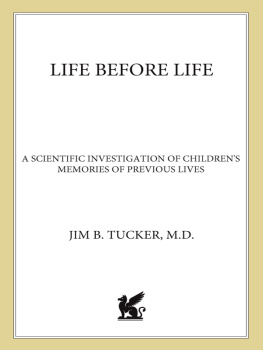The author and publisher have provided this e-book to you for your personal use only. You may not make this e-book publicly available in any way. Copyright infringement is against the law. If you believe the copy of this e-book you are reading infringes on the authors copyright, please notify the publisher at: us.macmillanusa.com/piracy.
Young children sometimes say they remember a different life before their current one. Many of them give enough specific detailsthe area where they worked as an incense maker before being hit by a bus for instance, or the name of the aircraft carrier their plane flew off of before it crashedso that this other life can be identified.
What do we make of thatcan past lives be real?
At the University of Virginia, weve spent the last sixty years trying to answer that question, trying to figure out the best way to explain this phenomenon. The work started with Ian Stevenson, an iconoclastic physician who was chairman of the psychiatry department at the medical school. He became intrigued by such cases in the early 1960s and ended up giving up his position and prestige as chairman to focus on the research. After setting up a small research unit, now known as the Division of Perceptual Studies, he spent decades studying cases from all over the world. He also got others involved in the research, including me.
I was a child psychiatrist with a busy private practice when I got interested in the work in the 1990s. At the time I met Ian, he was a dignified manoften wearing a three-piece suit to workwho was approaching eighty while still publishing papers and books prolifically and traveling halfway across the globe to investigate cases. I enjoyed seeing patientsand I still dobut here was an opportunity to also be part of something bigger, to explore in a completely serious-minded way the question of life after death. I soon left my practice and joined the effort.
With this new two-in-one edition, you can assess the results of our labors. Life Before Life is an overview of the work, examining the different aspects of the cases, as well as a greatest hits collection of sorts, with summaries of cases ranging from Asian ones Ian studied in the 1960s up to American cases in the 2000s. Then in Return to Life, I recount my investigations of a number of recent cases, including what are probably the two best known American cases: James Leininger, who remembered being a World War II pilot, and Ryan Hammons, who remembered being a Hollywood extra.
Those two cases show that in addition to documenting the veracity of the childrens reports, part of whats exciting about this work is how the cases give clues about what survival after death might entail. Some of the children provide intriguing descriptions of events from their time between lives, sometimes including verifiable information. Both James and Ryan gave startlingly accurate details about their parents activities around the early time of the pregnancy. The cases also indicate that with multiple lives, some aspects of one life carry over to the next. This carryover often includes traumatic memories of a violent death, but it can also include warm, positive emotions, as some of the children voice great affection and sometimes longing for loved ones from before. Along with knowledge about past events, love and attachment appear to survive as well.
Toward the end of Return to Life, I try to include our cases in a more general exploration of the ultimate nature of existence. In the penultimate chapter, I venture into quantum physics territory in order to make the argument that consciousness is the core of reality that the physical world grows out of, not the other way around. If thats true, it should not be surprising that an individual consciousness can survive after the physical brain dies, and in our cases becomes associated with a new brain and starts a new life.
There seems to be consensus among the people who have read Return to Life that this chapter is either the best or worst in the book. If its not your cup of tea, feel free to skip it. But I do think quantum physics offers insights that are relevant to questions about Mind and reality. Theres a reason why Max Planck, the founder of quantum theory, said he regarded consciousness as fundamental and he regarded matter as being derived from consciousness.
Our work contributes to the evidence for such a position. If our cases are what they appear to be and children really do have past-life memories, they cannot be mapped onto a materialist view of reality. If the materialist viewthat physical matter is all thereis correct, then its impossible for children to remember previous lives. Yet some children do.
Ive now been engaged in this research for twenty years, and I continue to be impressed by new cases. A while back, I met Grant, a little boy who, from a very early age, told his mother that she was not his only mommy. When he was five, he asked his parents if they remembered when he was in the war. He said he was in the army and described being on the beach and in the jungle. He said it was 1969, and when his parents asked him if he was talking about Vietnam, he told them he was. He said he had died in an explosion when he was twenty-one. He gave the state he was from and his last name, an unusual one Ill call Slaven, which occurs with similar frequency in the United States.
His mother went to the Vietnam Memorial website and was shocked to see that a soldier named Slaven from the state Grant had said was killed in the war when he was twenty-one. She showed Grant pictures of various men on the site, and when they got to Slavens, he said, Oh, thats me. His mother then contacted our office and agreed to an interview.
Before meeting the family, I joined a virtual newspaper archive site and accessed Slavens obituary. Following leads from it, I was able to obtain certain details about his life, including his familys address when he was in high school.
I met Grant and his parents in their spacious home near a city in the middle of the United States that is rich with history. His parents came across as totally reasonable people. They are Catholic (though non-practicing), and his father in particular had initially been quite skeptical about a past-life connection. I brought along pictures to use as tests for Grant, who was still only five years old. I showed him pairs of photographs, one from Slavens life along with a control picture, one that had nothing to do with him. When I showed Grant a picture of the Slaven familys house along with a control picture, Grant said he didnt remember either one. Of course, I dont know how the appearance of the house may have changed over the last fifty years. I then showed him a picture of the house across the street from the Slaven home along with a control, and he pointed to the correct one and said he remembered it. Slaven went to a Central High School, and when I showed Grant pictures of two large Central High schools, he pointed to the correct one and said he had been to it.
After the meeting, I continued searching online for information about Slaven. I was eventually able to access his high school yearbook from 1968, the year he graduated. I emailed electronic copies of pages from the yearbook, along with pages from the 1968 yearbook of a different Central High School, to Grants mother. I sent three pairs: pages showing the schools administration, ones showing teachers, and ones showing students. I did not tell Grants mother which pages were the correct ones. Grant picked the one from Slavens school for all three pairs. When I told his mother the results, she replied, Oh wow, that is absolutely crazy!!! Again, wow, I am blown away that they were all right, he was so casual about it.









